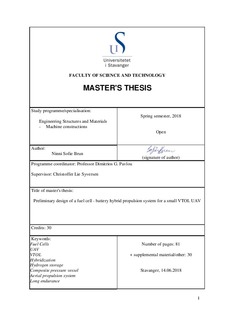| dc.contributor.advisor | Pavlou, Dimitrios | |
| dc.contributor.author | Brun, Ninni Sofie | |
| dc.date.accessioned | 2018-09-11T09:29:34Z | |
| dc.date.available | 2018-09-11T09:29:34Z | |
| dc.date.issued | 2018-06-14 | |
| dc.identifier.uri | http://hdl.handle.net/11250/2561949 | |
| dc.description | Master's thesis in Mechanical engineering | nb_NO |
| dc.description.abstract | Over the past decade, utilization of unmanned aerial vehicles (UAVs) in military and commercial applications has increased significantly. The vertical take-off and landing (VTOL) UAV is appreciated for its easy launch and versatile operation capability, but the missions are limited due to low endurance. Hybrid fuel cell systems have the potential to increase the endurance significantly. Until now, the use of fuel cell systems in VTOL UAVs have been limited to demonstrations, but as new and lightweight fuel cell systems have been developed, the technology seems to have reached the maturity level needed to realize fuel cell powered VTOL UAVs for more widespread use. This paper considers the implementation of a hybrid fuel cell – battery system on an existing VTOL UAV with maximum take-off weight (MTOW) of 25 kg. The available technology for fuel cells and hydrogen storage are investigated with the aim of determining the best solution for this UAV, and a preliminary design of the entire propulsion system is done. The selection of different components is based on power estimation from momentum theory. The hydrogen storage is a customized spherical composite pressure vessel. A comparison between cylindrical and spherical pressure vessels are performed to justify the use of a spherical pressure vessel. The calculations are based on classical lamination theory. The results indicate that a spherical pressure vessel gives weight savings of 15 %. The estimated endurance of the proposed system is 3.2 hours at MTOW with a custom spherical pressure of 21 liters. This is a 7-fold improvement compared to the current installed batteries. | nb_NO |
| dc.language.iso | eng | nb_NO |
| dc.publisher | University of Stavanger, Norway | nb_NO |
| dc.relation.ispartofseries | Masteroppgave/UIS-TN-IMBM/2018; | |
| dc.rights | Attribution-NonCommercial-NoDerivatives 4.0 Internasjonal | * |
| dc.rights.uri | http://creativecommons.org/licenses/by-nc-nd/4.0/deed.no | * |
| dc.subject | maskinkonstruksjon | nb_NO |
| dc.subject | UAV | nb_NO |
| dc.subject | fuel cell | nb_NO |
| dc.subject | composite pressure vessel | nb_NO |
| dc.subject | hydrogen storage | nb_NO |
| dc.subject | brenselcelle | nb_NO |
| dc.subject | long endurance | nb_NO |
| dc.subject | aerial propulsion system | nb_NO |
| dc.subject | hydrogenlagring | nb_NO |
| dc.title | Preliminary design of a fuel cell - battery hybrid propulsion system for a small VTOL UAV | nb_NO |
| dc.type | Master thesis | nb_NO |
| dc.subject.nsi | VDP::Teknologi: 500::Maskinfag: 570::Maskinkonstruksjon og materialteknologi: 571 | nb_NO |
| dc.source.pagenumber | 81 | nb_NO |

